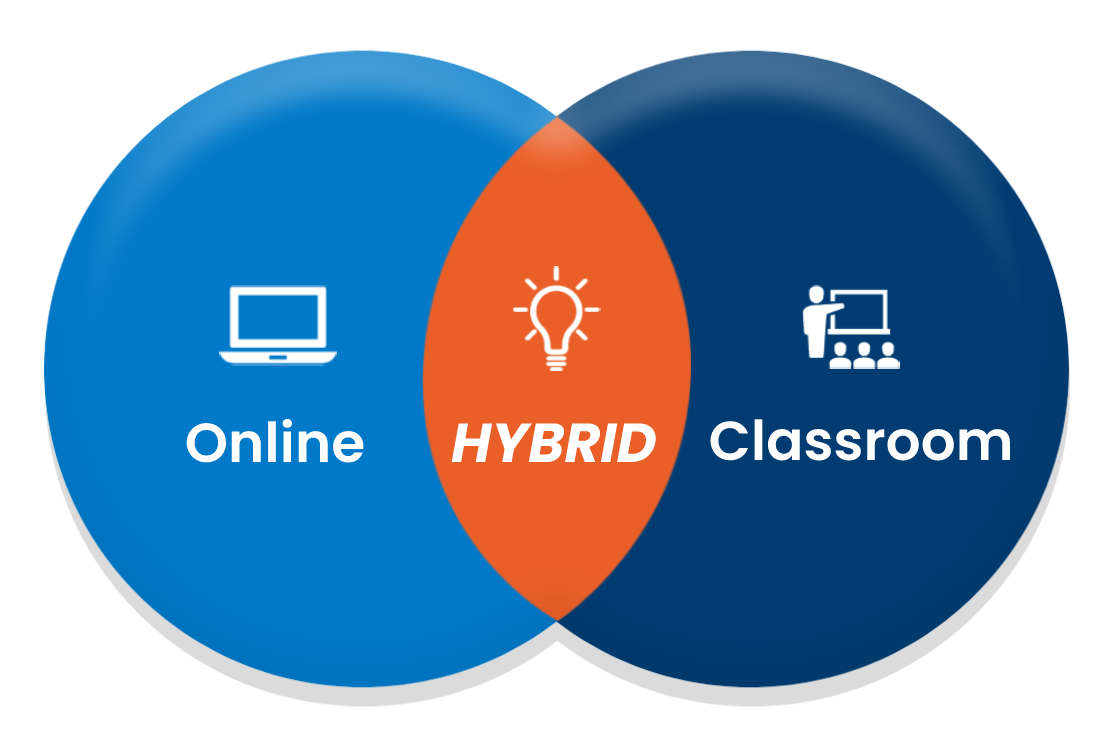Hybrid Course Models
Definition
Hybrid teaching is an instructional modality which integrates face-to-face (F2F) and online instruction and activities. With Hybrid teaching, the online components are intended to replace a portion of the face-to-face class time. As a result, the amount of in-person meetings is reduced. The image below depicts the integration of face-to-face and online teaching to create the hybrid instructional modality.

Explanation
Understanding Instructional Modalities
We previously referred to Hybrid Teaching as an instruction modality. The term instructional modalities refer to the various ways courses can be delivered to students. In other words, these are course delivery methods. Identifying a suitable instructional modality for any course is crucial to providing an optimal learning experience. Instructional modalities provide critical information to learners by setting expectations for their learning experiences. Below, we have created a comparison chart to outline the features of popular instructional modalities.
Instructional Modalities
-
Face-to-Face (F2F)
Traditional brick and mortar setting, where instructor and students see each other physically. For example, teaching in a physical classroom or lecture theatre. All activities occur in person, with no technology integration other than a PowerPoint.
-
Blended
Face-to-face learning with lots of connective technologies. All instructions occur F2F, however, technology is used to facilitate activities for homework, communication, student engagement etc. For example, using student response systems (such as clickers) in the F2F classroom is considered blended learning. A fundamental component of a blended course is that the technological components (even if online) are not intended to replace face-to-face class time. Instead, they are meant to supplement and build upon the content discussed in the classroom.
-
Hybrid
Hybrid teaching combines both F2F and online activities. The online components are intended to replace a portion of F2F class time, which reduces F2F time.
-
Online
Also called remote learning. This modality is fully online, without any F2F interaction. Online teaching can be synchronous or asynchronous.
- Synchronous classes run in real time, with students and instructors attending together “live” from different locations. For example, class sessions live-streamed via Kaltura, Google Meet or Zoom.
- Asynchronous classes run on a more relaxed schedule, with students accessing class materials during different hours and from different locations. Instructors and students do not interact with each other in real time. Asynchronous interactions may include pre-recorded video lectures that students watch independently. Students may be allowed to send follow up questions by email or through an online discussion thread facilitated in the Learning Management System (for example: Canvas). Instructions can also post video or audio files and lecture notes online for learners, and then post quizzes on the material to ensure students followed up with watching or listening to it.
-
Hybrid Flexible
Typically, Hybrid Flexible course modality combines three (3) course modalities, namely: F2F, Synchronous Online and Asynchronous Online. Essentially, the Hybrid Flexible modality delivers these three distinct modalities all at the same time for one course. Students are given the flexibility to select their preferred modality, and are also given the option to switch back and forth as desired. The underlying design foundation of the Hybrid Flexible Model is flexibility (Maloney & Kim, 2020). This kind of flexibility can be particularly helpful during times of crisis.
Application
Over the years, hybrid teaching has been widely practiced, and numerous studies have been conducted to ascertain its effectiveness. Studies have shown hybrid teaching to be a preferred format of choice for students. Additionally, studies indicate that learning outcomes and academic achievement are stronger with hybrid teaching than for either face-to-face or online teaching alone (Joosten et al., 2021). With these benefits in mind, Ontario Tech University has widely established hybrid instructional modality across its curricula.
Hybrid Models
Within the hybrid instructional modality, there are further sub-models that instructors can utilize. Here are a few hybrid models (Adapted from UBC Centre for Teaching, Learning and Technology).
Hybrid Model |
Description |
| Concurrent or Differentiated Hybrid | F2F and remote students attend class synchronously. Lectures are streamed live to allow two-way interactions. Differentiated activities are designed for students who are at home and those in person. |
| Multi-section or Multi-Track Hybrid | F2F and online instruction occur in separate sections, and each group is treated as an entirely different cohort within the same larger class. So, while students might learn the same lessons and the same objectives, they essentially function almost like separate classes. |
| Alternating or Class Rotation Hybrid | All students are required to attend some F2F instruction but perhaps in smaller groups. When not on campus, students engage in learning activities asynchronously online. In some cases, F2F and online instructions and activities could be rotated for all students. |
| Asynchronous Hybrid | F2F instruction is recorded and made available for remote students to access at their convenience |
Resources
UBC Centre for Teaching, Learning and Technology. (2020). Discussion Paper on Hybrid Teaching and Learning. Retrieved from https://ctlt.ubc.ca/files/2021/01/CTLT_HybridTeachingLearning.pdf
References
Joosten, T., Weber, N., Baker, M., Schletzbaum, A., & McGuire, A. (2021). Planning for a Blended Future: A Research-Driven Guide for Educators. [Report] Every Learner Everywhere Network. Retrieved from: https://www.everylearnereverywhere.org/resources/
Maloney, E. & Kim, J. (2020). Fall Scenario #13: A HyFlex Model. Inside Higher Ed.
